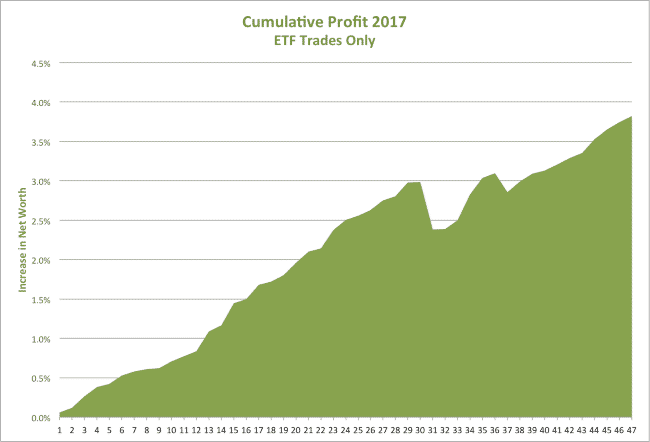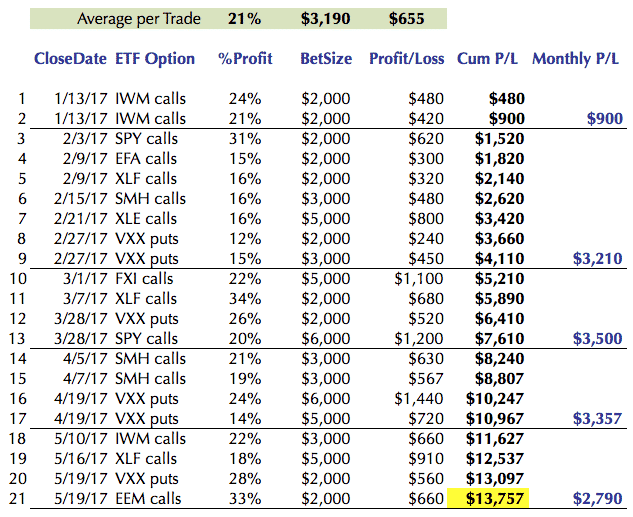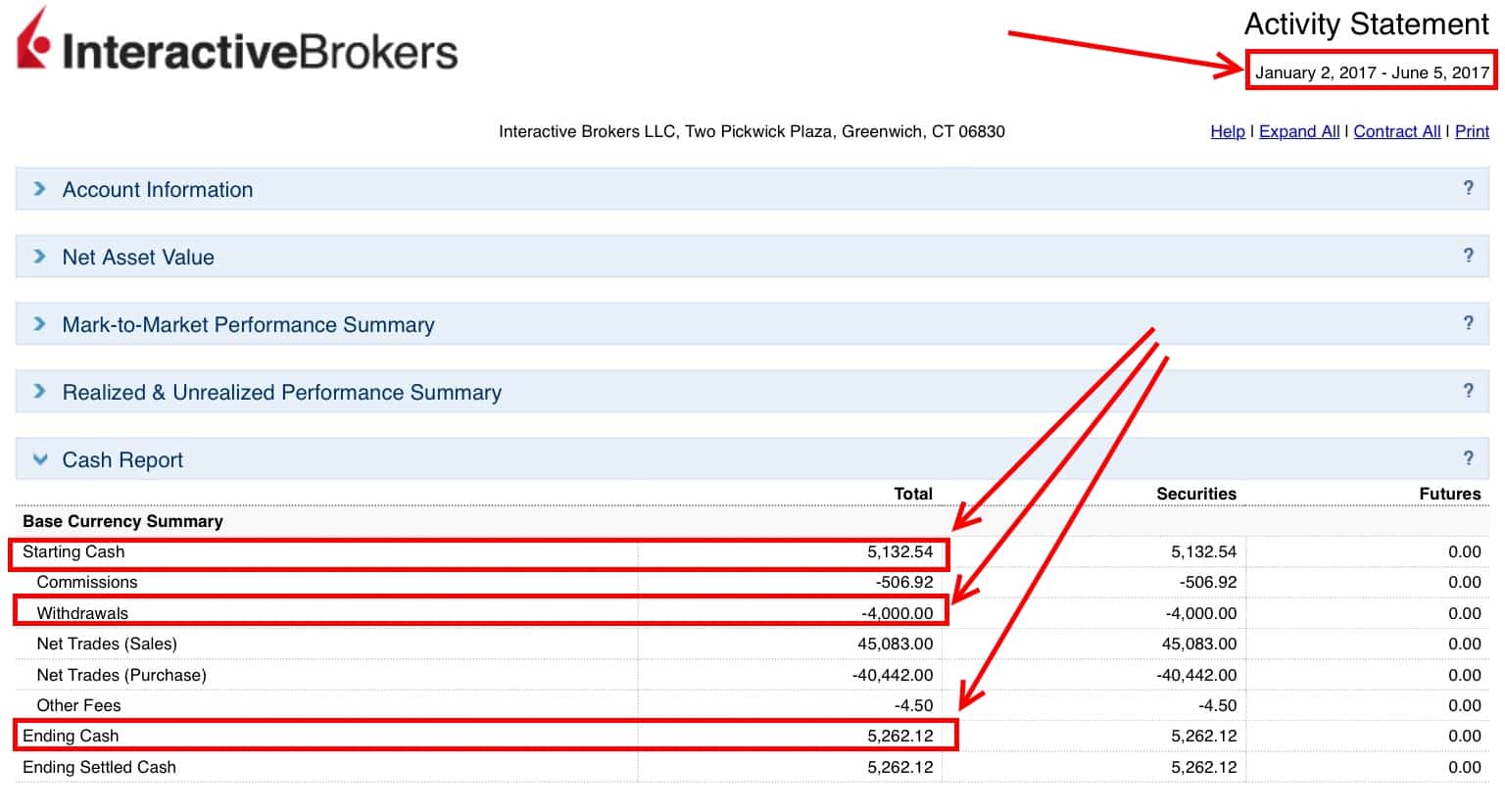Editor’s Note: The following is a guest post from Jack Loftis of ETFSwingTrader. Enjoy!
Nine years ago, I began trading the “mean reversion” that I still use today.
I was very unfamiliar with this type of strategy, and it seemed awkward to me.
Nearly a decade later, I have a new name for my ETF trading strategy: Reversion To The Trend.
In addition to becoming second nature, this trading strategy has also generated solid profits — trade after trade, month after month, year after year, and with over 700 trades publicly posted.
The graph below is a cumulative log of all ETF trades I have made so far this year.

As you can see, my ETF trades (all of which were shared with subscribers of my service) have generated a steady net worth gain of nearly 4% in less than six months.
Technical Swing Trader
The reason my trend version strategy was awkward for me at the start was because I was conditioned to other, more common styles of trading.
So, let’s compare several typical trading methodologies to contrast what I am doing.
In ancient times, we compared to primary ways of investing: Fundamental and Technical.
Fundamental investing (for the longer term) involved detailed analysis of each company and its financial prospects.
Technical trading, however, relied on charts of the price movement itself, not inferences about future price based on “fundamentals.”
My ETF and ETF option trading strategy is a technical approach commonly known as swing trading.
This means I look for short-term “swings” in an ETF, based on what its price chart tells us.
Swing trading works great for me because it fits my personal disposition and attention span.
My typical holding time is 5 days; I’m safely in cash the rest of the time.
Trend Following vs. Breakout Trading vs. Trend Reversion
Within the realm of technical swing trading, there are a few popular trading strategies to choose from.
So, let’s look briefly at the other, perhaps more familiar, approaches to short-term trading.
Trend Following
Trend following is a proven method of identifying large trends in an equity’s price, hopping on that trend, and holding on for what is hopefully a long ride.
The Turtle Traders were a famous example of this approach, but this method involves many false starts (and small losses) before one of these trends is discovered.
How many veins of gold must the prospector try before he finds the one that goes on “forever?”
Breakout Trading
Breakout trading involves finding a stock with solid momentum that begins to pause and build a sideways base.
When the stock rallies above resistance and “breaks out,” breakout traders jump into the stock.
If you’ve picked the right stock, then a great deal of momentum has built up in the stock while it was building its strength.
Breakout trading is like grabbing a tiger as it escapes its cage, then holding on for dear life.
This trading strategy requires patience, but often results in double-digit percentage returns.
As you may know, Breakout Trading is the basis behind the Morpheus trading strategy employed every day in The Wagner Daily newsletter.
The infamous cup and handle formation is one well-known example of a breakout trade setup.
Trend Reversion
Both strategies above can be extremely successful when applied with a high level of discipline and patience.
But what if you are an impatient person who is not comfortable with the longer holding times required for Trend Following and Breakout Trading?
What if you possess a temperament that drives you to only be satisfied with the sweetest part of a stock or ETF’s move?
In these cases, Trend Reversion may be the perfect strategy for you!
Rather than build positions in a number of equities and patiently wait for them to break out into a strong profit, I prefer to make small percentage profits on trades that end up in the green 90% of the time.
This is also known as “high probability” trading.
By the way, this is not some “bright idea” I personally dreamed up one late night.
Larry Connors, famed hedge fund manager and system developer, created this basic approach that has been tested systematically and exhaustively.
Winning ETF Trend Reversion Strategy: How It Works
Generally, I am dealing with an ETF that has a general directional trend going, and has briefly pulled back from that trend.
I jump on this pullback and hold on for the 5 days or so it takes to “rubber band” back to its ongoing trend.
Then, in a whisker, I take my profit and am off in search of my next victim.
And with “inverse” ETFs, you can profitably trade when the market (or an individual ETF) is moving down as well.
Using leveraged ETFs, you can multiply your dollar profit as well.
Of course, buying something “on the pullback” is an approach we hear about all the time.
But instead of doing this based on “feel,” I select and execute these pullback maneuvers in a very precise and rule driven fashion; this means you can easily replicate my trading system.
To increase my win rate (which I’ve maintained at over 90% since August of 2011), I use a well-tested, methodical strategy of “averaging down” — progressively building trades, rather than jumping in all at once.
All this results in a well-focused trading approach in which I am only in 2-3 trades at a time, but committed with a large position of each ETF in my portfolio.
This requires a very well-honed selection process, as well as careful trade management of positions after they have been established.
But with my daily newsletter service, I have made this winning trading system dead simple to follow!
One hour before the market closes, I simply send you a Final Trade email with the trades I am taking (or selling or holding) that day.
I do my trades with Market on Close orders to simplify the ETF trading process; it could not be easier to do.
Works Great For Options Too
If you have a smaller account that requires exceptional performance, please note that I also provide OPTIONS versions for many of these ETF trade setups.
So far this year, I have won every option trade since the first week of 2017.
That equates to 21 option trades, with an average gain of >20% per trade.
Here’s the proof:

If you have a small account, you may also be interested to know that I began trading an actual $5,000 account this year, withdrew $4,000 in profit, and still have a $5,000 account balance.
Here’s a screenshot from my broker that shows it (press image to enlarge):

After seeing the all the winning trades above, let’s get one thing clear: I do not win on EVERY trade, but I do consistently keep up a win rate of >85%.
Do you think you personally could make money with an approach that has been fine tuned for the past 8 years to consistently yield the kind of outstanding results discussed above?
I’ve reached the point where I can now support myself with my trading profits.
Start your trial subscription now to find out if this winning system is right for you too.
As always, please feel free to personally contact me by email or phone with any questions or comments.
Cheers,
PS – Join nearly 13,000 followers of my StockTwits feed to see the thousands of trade ideas I have publicly shared over the years.
